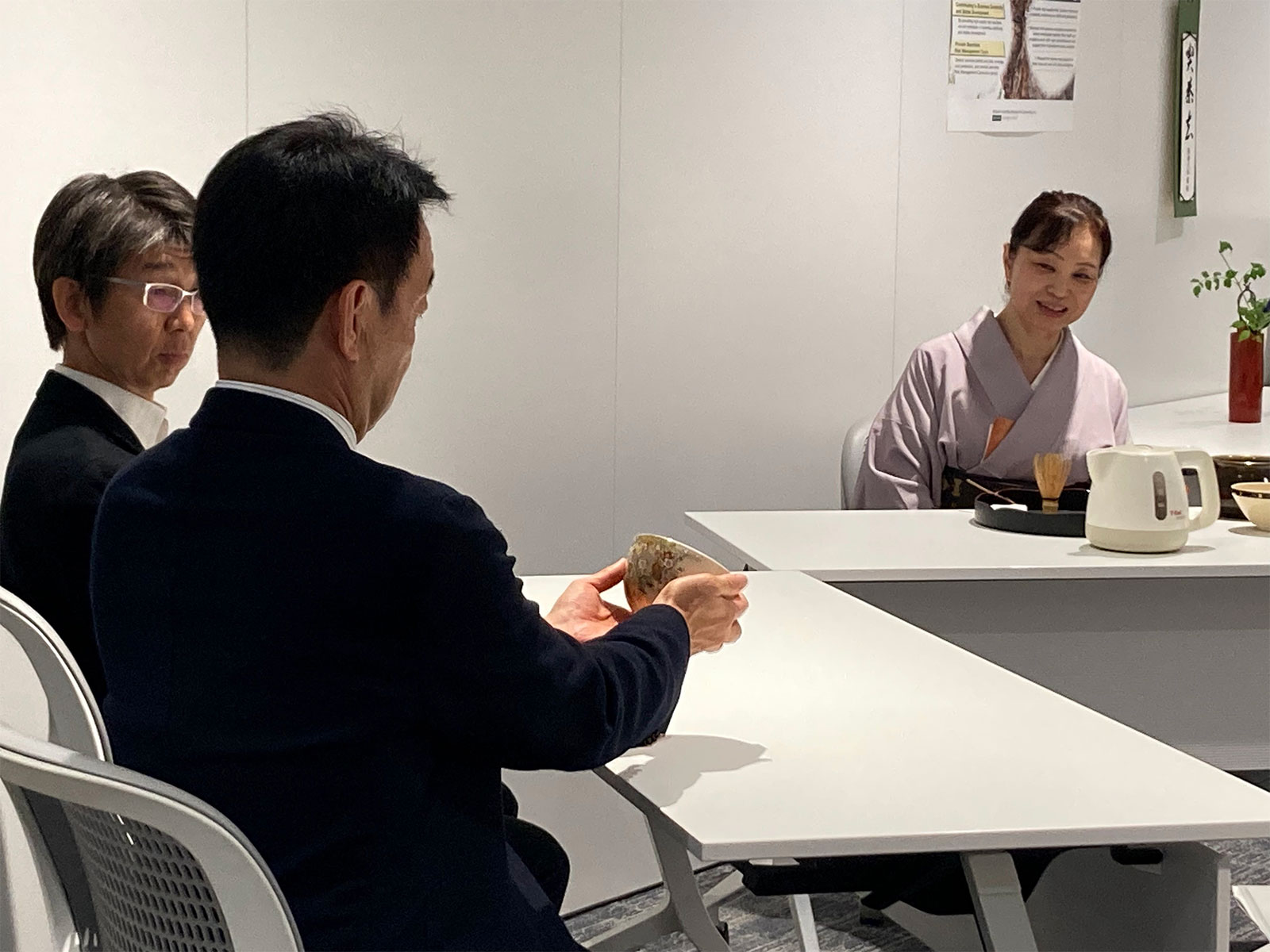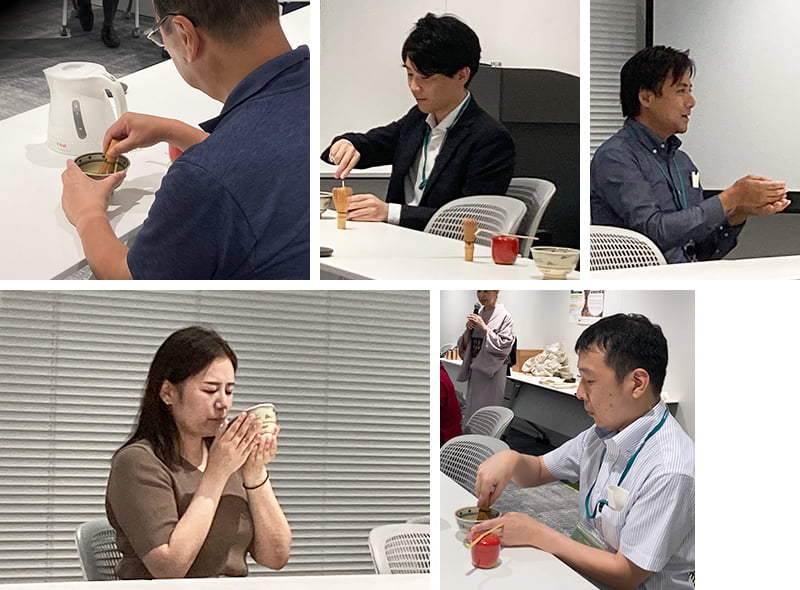- TOP
- Stories
- Tea Ceremony Training Report: First "tea ceremony" experience for employees at MS&AD InterRisk Research & Consulting (4)
- Business Solution
Tea Ceremony Training Report: First "tea ceremony" experience for employees at MS&AD InterRisk Research & Consulting (4)
By: Yoh Otsuka (Senior Fellow & Senior Consultant, Intelligence Group, Nikkei Business Publications)
MS&AD InterRisk Research & Consulting (Chiyoda-ku, Tokyo) is an MS&AD Insurance Group company in the business of risk-related services. It offers events and in-house training opportunities to the employees aimed at promoting their wellbeing. In March 2023, the company invited a Zen monk to hold a seminar on mindfulness practice, followed by another seminar in September, this time focusing on the tea ceremony.
The author was invited to give a corporate training session titled "Experience Tea Ceremony Tips for Business" in a conference room at the office of MS&AD InterRisk Research & Consulting. The training consisted of three parts: a lecture, a tea ceremony, and a "hands-on experience." Seventeen people from the company participated in the training, both in-person and online.
At the beginning of the session, the author gave some tips on how to apply the spirit of a tea ceremony to business. She explained that communication skills can be improved by learning the tea ceremony, that inspiration and creativity can be expected in the unusual setting of a tea room, and that leadership and project management skills can be acquired by holding tea ceremonies.
At the end of the lecture, she introduced the "Shiki Shichisoku" (or "Seven Rules of the Tea Ceremony") created by Sen no Rikyu, a famous tea ceremony master. "Shiki" is a four-character phrase meaning "harmony, respect, purity, and tranquility," and it expresses the state of "harmony between host and guest," "mutual respect," "keeping utensils and mind pure," and "having a steadfast mind that will not be disturbed under any circumstances."
The "Shichisoku," or the seven rules are: "Make the tea in a way that the guests will enjoy drinking it," "Add charcoal so that the water will keep boiling," "Arrange the flowers so that they will look natural as if in the field," "Entertain the guests so that they can cool down in the summer and warm up in the winter," "Stay ahead of the clock," "Be prepared for rain at all times," and "The guests should also be mindful of each other." The first four are mainly for the host, while the latter three are mainly for the guests.
All seven rules may seem obvious, but they are difficult to follow to perfection. To stay ahead of the clock is valuable advice for time management, while to always be prepared for rain can be thought of in terms of risk management, so both of these are useful in the business world.
A strip of paper with the expression "Kisakko" (meaning "have a cup of tea") written on it was hung on the wall, and a red bamboo vase with gentian and other autumnal flowers was placed underneath it.
![[Tea Ceremony Training Report] Employees experience "Tencha" for the first time at MS&AD Interrisk Research Institute](/nikkeiinfo/en/global_services/240131_nikkei_bp_img_01.jpg)
Author explaining Sen no Rikyu's "Shiki Shichisoku." On the wall, a strip of paper with the expression "Kissako" on it.
A Cup of Thin Tea in Casual Style
The second part of the training session focused on the "bon-ryaku-temae," a rudimentary form of tea ceremony taught in the Urasenke school of tea. It is a method of preparing tea with the minimum necessary utensils, such as a tea bowl, a tea container, a tea scoop and a tea whisk on a tray, making it easy to enjoy a tea ceremony anywhere. On the day of the training session, the utensils were placed on the tables in the conference room, and hot water from an electric pot was used for the tea ceremony.
In a previous article, the author mentioned the "ryurei" method, in which the utensils are laid out on a table and the participants sit on chairs. This method, which combines the "ryurei" and the "bon-ryaku-temae" styles, allows participants to experience the tea ceremony in corporate offices and other locations without the need for a tatami room.
When there are multiple guests at a tea ceremony, the person seated in the most senior position is called the shokyaku. The shokyaku is the guest of honor and represents all the guests in conversation with the host. The next guest, or the jikyaku sits next to the shokyaku, then the third, and so on, until the last guest, who is called the makkyaku or the tsume.
On the day of the training session, MS&AD InterRisk Research & Consulting advisor Terumi Nakamura served as the shokyaku and Masahiro Morimoto, wellbeing general manager, took the role of the second guest.
The Guest's Manners Are Also Important
At a tea ceremony, there are many occasions upon which the host and the guests, or the guests alone, bow to each other. The guests also bow to the hanging scrolls and other utensils as a sign of respect.
Before starting the tea ceremony, the host and all the guests bow to each other. This is called sorei.
When a bowl of tea is served, the guest places it between him- or herself and the neighboring guest then says, "osakini (itadakimasu)" and bows. The meaning is to offer the tea to the first guest before the second guest. The first guest then places the tea bowl in front of him- or herself and says to the host, "otemae chodaishimasu," signifying that he/she will accept the served tea. After this, the guest will hold the tea bowl in both hands and raise it slightly above eye level.
Before drinking the tea, the guest is supposed to turn the tea bowl twice clockwise. The reason for this is to avoid putting his/her mouth on the front of the tea bowl, which often has a design painted on it. After drinking, the bowl is turned counterclockwise to return the front part to its original position.
The next act of the guest is to "look" at the bowl to enjoy its shape and texture as a whole, take a closer look at the painted design, check the name of the artist engraved on the back of the bowl, and appreciate this tea implement that the host has prepared.
In this way, each gesture that a guest performs while enjoying a single cup of tea is connected to his or her appreciation of the host and to the consideration that guests give each other. Mr. Nakamura and Mr. Morimoto also performed such series of gestures before drinking the tea.

Mr. Nakamura (right), the shokyaku, and Mr. Morimoto, the jikyaku, both looking at the tea bowl
Employees Experiencing a Tea Ceremony for Themselves
In the third part of the training session, the participating employees were given the opportunity to try making thin tea themselves.
First, a tray containing confectionary was passed around, and then each employee took one onto a piece of "kaishi" paper. The confectionery prepared for this event was Obusedo's rakugan. When passing around the confectionary, each participant would say "osakini" before passing the tray to the next person, just like when drinking tea.
After that, tea bowls were handed out and participants scooped out matcha from a tea container with a tea spoon and put it into the bowl. Most of the participants had never used a tea whisk before, but they all whisked the tea beautifully. After one person had made tea, the next person would drink it, giving everyone a chance to make tea and drink a cup that had been made by someone else.

Ms. Sonoko Yamaguchi, wellbeing manager, and Ms. Sachiyo Nishiyama, assistant, who served as the training secretariat for the day, had experience in tea ceremony, and were in charge of carrying tea made by the participants to the guests. Ms. Yamaguchi noted that the participants seemed to enjoy the tea ceremony, and all looked very happy. She said, "It was my first time to experience ryurei-style tea, but I felt it was a good introduction because the hurdles are low."
Mr. Morimoto, the jikyaku of the bon-ryaku-temae ceremony, said, "For some reason, I felt refreshed after the training session. I could understand why feudal lords and famous business owners, who sharpened their nerves every day, were lovers of tea."
For further details, please contact:
Nikkei Business Publications, Inc.
NIKKEI BP

"Foresee the future, Unlock the insight" is the expression that describes our mission. As Japan's leading BtoB media service, we meet diverse business community needs in the three key categories of "management," "technology" and "lifestyle."
See More
